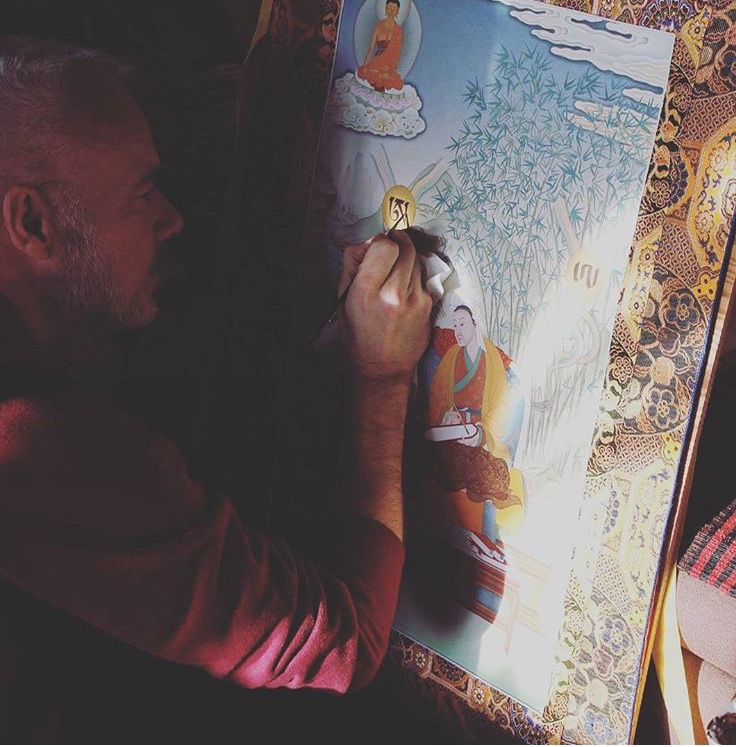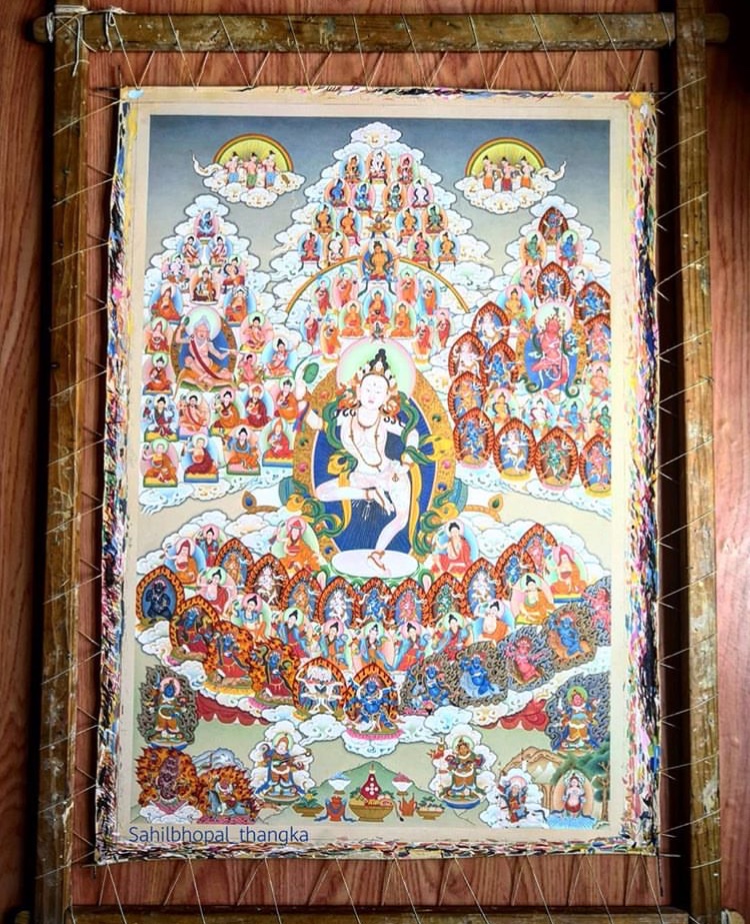Thangka painting – a sort of scroll painting, is a cultural pillar in Tibetan tradition and is essential for Buddhist practitioners as it serves as recorded history. With a deep love for history and the intricate designs, Sahil Bhopal, an artist from Kullu has been painting Buddhist thangkas out of pure passion for 10 years now.
Trained in the Karma Gadri style, it is his love for art that transcends even religion. Talking about his work, he says, “Most of the time, when people look at my work, I see them be present in the moment. Nothing from the past or future is on their mind, they are fully present. I would like them to hold on to that peace and that moment of nothingness.” Read more about his fascinating journey below.

Meet our painter, Sahil, with his tangka painting behind him.
-
Hello Sahil, welcome to R&L! Please share a bit about yourself.
Hi, I am Sahil Bhopal, a 29-year-old full-time thangka painter, trained under the tutelage of master painter Noedup Rongae in the Karma Gadri style.
I was raised in Ladakh and when I was 16-years-old I started living in Kullu, Himachal Pradesh (where i’am truly from). Now I work out of a small studio in Boudha, Kathmandu. My journey of thangka painting began in Shambhala Art School, Kullu. I have travelled all-over Northern India and am also passionate about, meditating, spirituality, and about the Chinese and Japanese arts. I would call myself a ‘life-long learner’.

The detailed work on the paintings requires expertise

At his studios
-
What is Thangka painting? Tell us a little bit about its history.
Thangka painting is a form of traditional scroll painting. The word “Thanka” took life from the Tibetan word “thang yig” which means written record, therefore Thangkas are not only a work of art but are a way to record iconography and lineage. This is essential for a Buddhist practitioner, mostly for meditation and visualisation practices. Most of my work goes to a Buddhist practitioner who uses it for the same purpose.
There are a few different ways to paint thangkas, the one I’m trained in is called the Karma Gadri style. This form of painting is deeply rooted in the eastern Tibetan tradition, incorporating different art styles beginning all the way from the 16th century.
Each piece can take one month to years to finish, working 8 hours a day (what I do) – depending on the size, number of figures and complexity. Thangkas are not the product of artists’ imagination but are carefully executed blueprint drawings that portray a story.

“After completing the Je Tsongkhapa thangka , getting some tips from Mr Noedup Rongae about the art of rolling big thangkas perfectly! I feel lucky and blessed to be his disciple and part of this community.”
-
Who has influenced your craft?
One of the most important people in the history of thangka is Tai Setu Panchen (1700-1774). He revolutionised this art form in the 16th century. His way of painting, The Encampment style, was a revolution in Tibetan art, He placed Indian-inspired figures into the backgrounds of Chinese-inspired landscapes. This created more space and produced strong contrast to the figures. Even to this day, we look at his works for reference.
To me personally, my teacher is my inspiration. I met him 10 years ago in Himachal Pradesh and things have never been the same. Mr Noedup Rongae is 75 years now and he comes from a family of thangka painters. His father was a thangka painter and so is his brother. He started training under his father when he was 8 and he has painted hundreds, maybe thousands of thangkas, since then.

“Painting workshop: We worked on mudras – most of them were around 18, the same age I began thangka.”
-
What sparked your fire and got you to begin this journey – any connection to your roots?
In Ladakh, most of my friends were Buddhists and the region had many old monasteries, which I used to visit with my parents during holidays or other occasions. I was fascinated by the wall murals and masks but even then I had no idea I would become a thangka painter.
When I was finishing high school, my family got into a financial crisis. It was then that I took a gap year and discovered thangka painting as a hobby. Tibetan motifs always fascinated me, I was drawn to them. With a little bit of research, I found an art school in a Buddhist monastery near my home in Kullu valley and participated in a workshop.
The first few weeks, I didn’t think I would continue it as a profession because I wanted to continue my studies. But slowly I felt an unavoidable connection. All those years I spent in Ladakh visiting monasteries had subconsciously made an impact on my mind and created a strong love for this art form. I then decided to join the full time course. Suffice to say, I did not choose thangka, thangka chose me.

White Tara
-
Tell us a little bit about your journey after you decided to go full time with this?
The history of this art form is what intrigued me the most. Also, how much care and dedication my teacher put into a painting. He never worried about finishing the painting, he would patiently give it his best. This struck a chord with me.
I started Thangka in 2008, it has been almost 10 years now. My journey has its ups and downs. Coming from a Hindu background and a different culture entirely – I had to put extra effort in understanding the culture, to become the storyteller that I am. Also, trying to explain my craft to the people in my background or culture is difficult. For example, sometimes I have to paint deities in the nude, which is common for a Buddhist practitioner, but not for my family. I can’t share what I paint. But today I have found a balance.
I keep myself motivated and surrounded by people who inspire me. My journey has been incredible so far and while there is no set plan for the future, surprises and suspense is something that keeps me going.
My favourite painting to date is ‘White Tara’. It was my first painting and is now hanging on my wall back home. I think it will always be special to me as it reminds me of how I started out.

The thangka of Thonmi Sambhota – displayed in his upcoming book.

Tashi Mannox, renowned Tibetan Calligrapher working on our collaboration.
-
Who have you collaborated with? Also, tell us about what we can take away from your work?
One of my most interesting collaborations was with a world-renowned master calligrapher, Tashi Mannox, I painted ‘Thonmi Sambhota’ (the inventor of Tibetan script) for him.
Most of the time, when people look at my work, I see them be present in the moment. Nothing from the past or future is on their mind, they are fully present. I would like them to hold on to that peace and that moment of nothingness. My paintings are a result of immense patience and I want people to learn to use patience for the things they are trying to achieve.

The mother, Machig Labdron a creation from a reference image from the 16th century. The painting took nearly two years to make and has 116 figures in total.
-
Tell us a little bit about what you are working on now.
Lately, I have been working for my upcoming exhibition in the Nepal Art Council which is set in November. The theme is about Padmasambhava, a yogic saint who played an important role in spreading the Vajrayana teachings of Buddhism across Himalayan regions.
I believe traditional artists are bridges between the past and present and they play an important role in socioculture. They do have the responsibility to evolve their craft yet preserve everything that is important about it so that the future generation will continue the tradition. I have been expanding my skills into digital art in an effort to evolve.
We are excited about Sahil’s exhibition and for his incredibly bright future! Check out his amazing display of artwork on his Instagram and his WordPress!
- “While Studying in France, I Discovered Farm to Table Concept, and That Inspired My Fresh Food Venture” – Chat With Sriram Nair, Owner of Terra Cafe, Ahmedabad - September 14, 2020
- A Chat With Ashwin Chikerur – an Urban Sketcher and a Designer from Pune - October 31, 2019
- Dina Weber from Germany Chats About The Art and Soul About Bread-making and Her Bakery ‘SAPA Sourdough & Pastry’ in Mysuru - October 29, 2019
